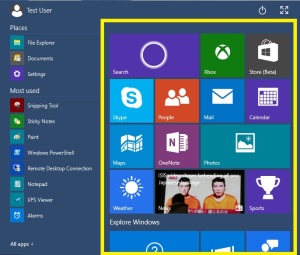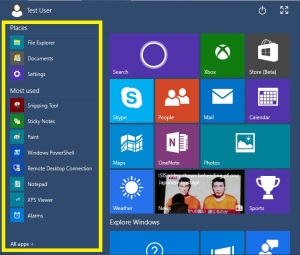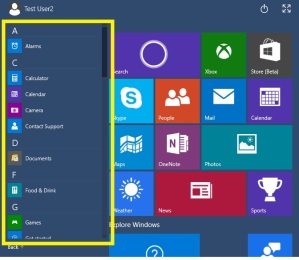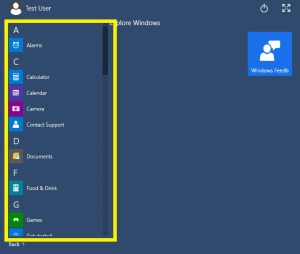While some may consider my last few Microsoft posts as overtly negative, or even as Microsoft-bashing. That’s not really my intent. As a disclaimer, the same goes for this post: also not intended as a Microsoft-bash. Microsoft is a very powerful software company that produces a bunch of very popular products, providing real value and utility to lots of people. Microsoft products generally offer reasonably high quality, and more importantly: people vote with their wallets and continue to purchase Microsoft products. When you look at the biggest players in most any industry, blemishes are easy to see because: more people are exposed to them, and statistically there are more blemishes, just as there are more beauty-ishes.
Side Note: If you maintain the same level of quality but produce twice as many products, you’ll have about… twice the number of bugs – which people will see. But more accurately, each software application is no more buggy than before, it’s just a matter of perception. Being a successful and established company cuts both ways, good and bad. In fairness, argument goes past perception. Some may even argue that the biggest players in most any industry will become complacent, where bureaucracy and rules overshadow what’s really important. As part of this argument, its natural to ask if the company’s quality is diminishing because it’s investing more into FUD, and reacting to perceived market pressures – but that’s a post for another day.
I became a user of Microsoft products in the Apply II / IBM PC era. In 1978, shortly after the Apple II came out I ventured off to computer camp at the local university. That university’s lab only stocked Apple II computers, so I started writing software exclusively on the Apple II. Over the next few years, I migrated to the IBM PC as more friends got PCs. Since my parents didn’t see much value in buying a “game machine” (e.g. Personal Computers could play games, games are bad, thus…. PCs are bad). So, my hobby software development was when and where I could get it. I’d go to friends homes and… when they started watching TV, I’d fire up their computer. Sometimes I’d write on an Apple II, II Plus, IIe, but more often friends had an IBM PC. And as I wrote more hobby programs, I started bringing around a floppy disk (e.g. the USB key of 1980) so I could continue development on different computers. Ultimately, all I was working on was PC because my PC programs didn’t run on Apples, and thus an Apple II didn’t do me any good.
Back then IBM was number one, and Microsoft was just an upstart competitor trying to get some traction in the world. Since they were the embodiment of lean and hungry, Bill Gates and crew (but mostly Bill) focused and drove product offerings while cutting deals and making connections. The small band of Microsofties commonly criticized the ineptness of the large monolithic empire, as known as IBM. Yes IBM was dominating, but complacent. its leaders couldn’t see the value of PC software, much less value of an a PC Operating System (e.g. DOS). IBM was merely continuing focus on what made them successful: business class hardware. IBM embodied the mindset: “Who buys software? Hardware’s where the money is!”
But before there was Microsoft, two students were attending Harvard: Bill Gates and Steve Ballmer. It was then that Bill and Steve forged a long lasting friendship, albeit somewhat improbable: Steve the large brash Jock with some book smarts, and Bill the wiry dedicated geek not willing to back down. Bill ended up leaving school to found Microsoft, and pulled Steve onboard after his graduation.
The rest we can say is history. Microsoft continued to successfully identity, develop and market products that people were willing and needing to purchase. And, just as importantly, Microsoft got an early toe-hold into the world of PC software while forging crafty and enduring business relationship with important partners. It was the relationships with other large companies that brought Microsoft their early, and often enduring windfalls. These partnerships were the essence, the very foundation, of Microsoft’s success. These partnerships were crucial because people didn’t just magic software onto their computers at home – because that’s impossible 😉
No, consumers walked down to brick and mortar stores where they were able to choose from a very limited selection of products preselected by that store’s manager. Or by that store’s area manager. Or, perhaps, that store’s company leadership. Yep, those early alliances that Microsoft forged with large partners are what put Microsoft where it is today. Since I didn’t own a computer, I’d settle for using what was available at a friend’s home. Since the IBM PC came with the BASIC programming language, I was able to write programs wherever there was a PC. (Shrewd move by Microsoft)
Now, here we are three decades later. Microsoft is now the dominate producer of PC software, and exactly where Bill aimed during the past 30+ years. Bigger and bigger, always moving forward. Always looking for new angles, new enhancements, and new markets for PC software. But in all fairness, they may have never gotten here if IBM hadn’t lacked the foresight, the vision, to see the PC software market for what it really was, for what is would become. Maybe that’s a poor choice of words “lacked the foresight”, because IBM was simply doing what large successful companies do: Focus on your offering, pursue incremental improvements, consider complimentary new tangents. At most, an industry leader expends a small fraction of available thought and energy into new areas. And, this effort is usually directed in a very controlled fashion: Invent things that complement existing offerings, things that don’t go too much against the grain.
Back in 1996 the Google momentum got started. While attending Stanford, Larry Page starts a research project to better understand this newfangled thing: the Internet. A friend of Larry’s by the name of Sergey Brin becomes involved and together they gradually hone their focus of building a better search engine. As I personally remember from that era, the internet offered great promise. It was a new means of communication, possibly even more significant than the advent of the telephone. In 1996, the internet was obviously the next big thing, that is if you weren’t already a large successful company such as Microsoft. In that year, Microsoft was busy shipping oodles of Windows 95, and was establishing itself as the dominant player in PC software. Bill, Steve and Co didn’t have their heads in the sand, and they did see this internet thing as something to keep an eye on. Something on which to perhaps even develop a few offerings. Quite simply they couldn’t just drop everything they were doing with Windows, and all the applications that they’ve have running on top of it. So, this resulted in Microsoft treating the internet as a something extra.
As a contrast in action, Google accurately identified how critical this Internet could become, while pouring all of their energy and time into making a tool so people could better locate things. Just as Larry and Sergey saw, I too was hugely frustrated with my inability to locate things out there. Without some sort of all high quality search engine, I’d waste time looking through news groups, emailing people, talking with friends, walking around the computer science lab looking for answers – all purposeful actions, but overall an extremely ineffective “search engine”. Here’s where the story gets interesting. Larry and Sergey not only identified the user need, but took action required to build an online tool so people could better use the internet. They correctly envisioned people needing to actually find things on the internet. Then they took action to fulfill this need. A daring proposition back then, when the highly expert, highly paid, and most powerful executive visionaries considered search as basically nothing. Yep, search was considered a non-entity by executives in tech companies. Any company with an inkling of internet presence was jumping on the portal bandwagon, and thus these business leaders basically said “no” to search. That era’s executive mindset was along the lines: “Why make a search tool that people would use to access your competitor’s site?”. It was a mindset that completely missed the boat, and was purely based on FUD (Fear, Uncertainty, and Doubt).
Larry and Sergey, on the other hand, saw Internet Search for what it truly was: a foundation for anyone wanting to use the internet. Even I, a lowly customer science undergraduate could plainly see the necessity and significance of online search. It’s not that these technology company leaders were dumb, but they sure were blinded by their self imposed Tunnel Vision of tweaking current strategies and using the past to predict the future. My personal take: It’s more often the lower-level people who know the problems, contain the passion, and have the vision. While the established leadership strives to maintain an even keel, often for the sake of pleasing investors with consistent quarter-to-quarter earning. A seemingly good investor strategy, but also a reliable way to hide problems and at times deliver disaster (e.g. January 1986: Challenger; February 2003: Columbia). Add to that these leaders probably didn’t need to search for anything on the internet. (There’s some derived advice for investors here: keep your eyes on the younger ones b/c they more likely identify new needs and pursue bold new paths, while the older more established leaders are more likely to tweak whats already there)
The working prototype of Google actually worked really well. But when Larry and Sergey tried shopping it around to large technology companies, they hear something like “Wow! that does work really well. But who needs search?”. In effect, these leaders were clearly blind to what was in front of them.
Larry and Sergey dedicated time, energy to what would become Google. They put their selves and reputations on the line. They ultimately got backing, looked for business relationships and partners.
In fact, all this was very similar to the path Bill and Steve took decades before in starting and growing Microsoft. But now in 1996 Bill and Steve were focusing on their business, which was the conservative / sane thing to do. And in doing so they completely missed the internet boat. It’s not that they didn’t see the internet coming, they just misjudge its future worth weighed against MSFT’s current (circa 1996) worth.
Microsoft still manages to hold considerable worth, energy, talent and passion. But now they’re competing in a market that plays by different rules. Now, there’s less benefit to closing big long-term deals with other big players, such as the Dells, the IBMs, the HPs of the world.
This new internet market really is very different. It’s a place where online access grants people the ability to instantly try new software for free, and without downloading anything. In effect, people magic software onto their computers (something impossible when MSFT was up and coming). People can embrace new applications and tell all their friends in a matter of moments. Just as rapidly people can quit using an application and spread negative reviews, and damaging comments. In short, people can sample without committing. Eons ago, before the internet, the only way to try new software was to purchase a desktop PC and then it was too late. Or, to visit a friend who purchased a new PC. Or, head to somewhere selling computers and check out the new software – while incurring some degree of sales pitching and pressure.
In this new online world large OEM networks just don’t seem to help as much. Having deals, contracts, negotiations with other large players just isn’t what it used to be. Don’t get me wrong, it still has some relevance – just ask anyone firmly in the anti-Microsoft camp, or anyone fully committed to Microsoft competitors (e.g. Apple customers).
But what I keep coming back to is Microsoft. Because, well, I still use a bunch of Microsoft products, just as many others do. In fact I even go one step further. I use Microsoft development tools (e.g. Visual Studio) to develop software specifically produced to run on Microsoft Windows. I do this out of choice, but as I said before, Microsoft owns most of the desktop software market. And it’s sort of natural to do what’s most needed, most relevant by the world. Yes it’s sensible, but also a trap. Just ask IBM. Just as Microsoft.
In fact, even ask Google, Myspace, Facebook and YouTube. In the online world people gravitate to new things that offer worth. It’s a natural thing for consumers, but a very unnatural thing for the most successful paper-smart companies in the world. Microsoft’s historically been dominate continuing to do what it does best. The same goes for the other biggest, most successful companies in their industry. My point is this tunnel vision of success is not limited to Microsoft, but applies to the biggest most successful companies. Consider the top 7 companies on the Fortune 500 list for 2008:
1 Wal-Mart Stores
2 Exxon Mobil
3 Chevron
4 General Motors
5 ConocoPhillips
6 General Electric
7 Ford Motor
Are those companies’ leaders making the right decisions for their employees? How about for their customers? Or, are those powerful CEOs, Boards of Directors, and top executives wearing the blinders of the past? Will they experience tunnel vision at those critical decision points? Will they do the right thing?
Ask any investor and he’ll tell you it’s generally the bigger risks that have higher pay offs. To state it more plainly: If you want to win big, then when it counts you’ll need to risk big. To that I’ll add: It’s critical to make good decisions, and having an ability to see the future can come in kind of handy.
At Microsoft, roughly 90,000 real people, with real lives work. For their sake, and for that of the people currently committed to using (and developing) windows software, I certainly hope Ballmer and his legion of highly compensated executives make the correct decisions, and have at least some inkling of future vision.
On a related topic, here’s an interesting observation on Ballmer’s strategy to achieve online dominance: A strategy of bottomless-pit online spending. I certainly hope that’s not Steve’s primary strategy. (Maybe it’s his Plan B)






